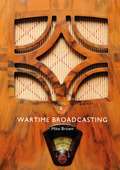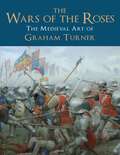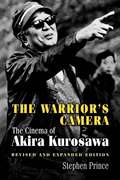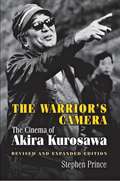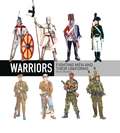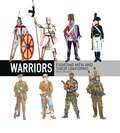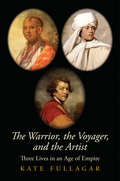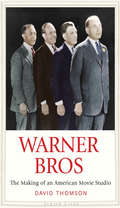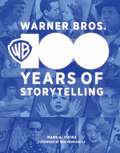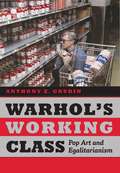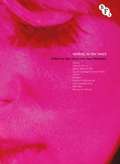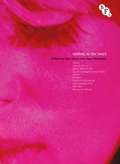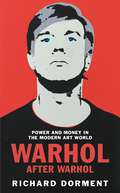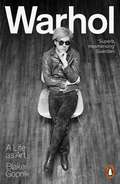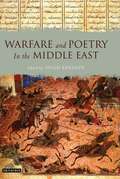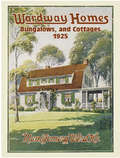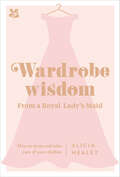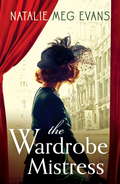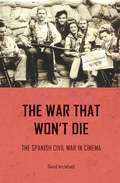- Table View
- List View
Wartime Broadcasting (Shire Library)
by Mike BrownOn 3 September 1939, Prime Minister Neville Chamberlain sat tensely at a microphone, using radio to declare that 'this country is at war with Germany'. During the ensuing wartime years, the BBC was the sole radio broadcaster in Britain, boosting morale through programmes such as 'ITMA' and 'Worker's Playtime'; helping the Home Front with useful hints and advice; transmitting government messages; and providing news. Personalities and stars became household names – Tommy Handley, Arthur Askey, Ethel and Doris Walters, Mr Middleton – and their catchphrases could be heard everywhere. And yet, as this fascinating book explains, the BBC chose to avoid propaganda, and had to tread a fine line between what the people wanted to hear and what it was felt they should hear.
The Wars of the Roses: The Medieval Art of Graham Turner
by Mr Graham TurnerA highly illustrated history of the Wars of the Roses based on the medieval art of Graham Turner.The period of civil strife in the second half of the 15th century now known as the Wars of the Roses was one of the most dramatic and tumultuous in English history. Since first being inspired by a visit to Bosworth battlefield nearly 30 years ago, renowned historical artist Graham Turner has built a worldwide reputation for his depictions of this colourful and troubled era, his paintings and prints prized by historians and collectors for their attention to detail and dramatic and atmospheric compositions. This new study contains a detailed history of the wars alongside a unique and comprehensive collection of over 120 of his paintings and drawings, many created especially for this book. It provides meticulously researched details of arms, armour, settings and countless other aspects of the period, while bringing to life the human stories behind the turbulent events.
The Warrior's Camera: The Cinema of Akira Kurosawa
by Stephen PrinceThe Japanese film director Akira Kurosawa, who died at the age of 88, has been internationally acclaimed as a giant of world cinema. Rashomon, which won both the Venice Film Festival's grand prize and an Academy Award for best foreign-language film, helped ignite Western interest in the Japanese cinema. Seven Samurai and Yojimbo remain enormously popular both in Japan and abroad. In this newly revised and expanded edition of his study of Kurosawa's films, Stephen Prince provides two new chapters that examine Kurosawa's remaining films, placing him in the context of cinema history. Prince also discusses how Kurosawa furnished a template for some well-known Hollywood directors, including Martin Scorsese, Steven Spielberg, and George Lucas. Providing a new and comprehensive look at this master filmmaker, The Warrior's Camera probes the complex visual structure of Kurosawa's work. The book shows how Kurosawa attempted to symbolize on film a course of national development for post-war Japan, and it traces the ways that he tied his social visions to a dynamic system of visual and narrative forms. The author analyzes Kurosawa's entire career and places the films in context by drawing on the director's autobiography--a fascinating work that presents Kurosawa as a Kurosawa character and the story of his life as the kind of spiritual odyssey witnessed so often in his films. After examining the development of Kurosawa's visual style in his early work, The Warrior's Camera explains how he used this style in subsequent films to forge a politically committed model of filmmaking. It then demonstrates how the collapse of Kurosawa's efforts to participate as a filmmaker in the tasks of social reconstruction led to the very different cinematic style evident in his most recent films, works of pessimism that view the world as resistant to change.
The Warrior's Camera: The Cinema of Akira Kurosawa - Revised and Expanded Edition
by Stephen PrinceThe Japanese film director Akira Kurosawa, who died at the age of 88, has been internationally acclaimed as a giant of world cinema. Rashomon, which won both the Venice Film Festival's grand prize and an Academy Award for best foreign-language film, helped ignite Western interest in the Japanese cinema. Seven Samurai and Yojimbo remain enormously popular both in Japan and abroad. In this newly revised and expanded edition of his study of Kurosawa's films, Stephen Prince provides two new chapters that examine Kurosawa's remaining films, placing him in the context of cinema history. Prince also discusses how Kurosawa furnished a template for some well-known Hollywood directors, including Martin Scorsese, Steven Spielberg, and George Lucas. Providing a new and comprehensive look at this master filmmaker, The Warrior's Camera probes the complex visual structure of Kurosawa's work. The book shows how Kurosawa attempted to symbolize on film a course of national development for post-war Japan, and it traces the ways that he tied his social visions to a dynamic system of visual and narrative forms. The author analyzes Kurosawa's entire career and places the films in context by drawing on the director's autobiography--a fascinating work that presents Kurosawa as a Kurosawa character and the story of his life as the kind of spiritual odyssey witnessed so often in his films. After examining the development of Kurosawa's visual style in his early work, The Warrior's Camera explains how he used this style in subsequent films to forge a politically committed model of filmmaking. It then demonstrates how the collapse of Kurosawa's efforts to participate as a filmmaker in the tasks of social reconstruction led to the very different cinematic style evident in his most recent films, works of pessimism that view the world as resistant to change.
Warriors: Fighting men and their uniforms
by Martin WindrowFrom ancient times to the present day, the world's finest warriors have been marked out by a stunning variety of dress, tactics and equipment. This splendid collection of artwork and commentaries illustrates famous combatants from all the ages of military history, bringing them to life in incredible colour and detail. From the gleaming plate armour of the medieval knight to the sleek camouflage gear of modern special ops forces, from the distinctive attire of the Japanese samurai to the ballistic armour and modern electronics of Russia's elite Spetsnaz, this is an unmissable tour of history's most impressive fighting men.
Warriors: Fighting men and their uniforms (Warrior Ser. #157)
by Mr Martin WindrowFrom ancient times to the present day, the world's finest warriors have been marked out by a stunning variety of dress, tactics and equipment. This splendid collection of artwork and commentaries illustrates famous combatants from all the ages of military history, bringing them to life in incredible colour and detail. From the gleaming plate armour of the medieval knight to the sleek camouflage gear of modern special ops forces, from the distinctive attire of the Japanese samurai to the ballistic armour and modern electronics of Russia's elite Spetsnaz, this is an unmissable tour of history's most impressive fighting men.
The Warrior, the Voyager, and the Artist: Three Lives in an Age of Empire (The Lewis Walpole Series in Eighteenth-Century Culture and History)
by Kate FullagarA portrait of empire through the biographies of a Native American, a Pacific Islander, and the British artist who painted them both Three interconnected eighteenth-century lives offer a fresh account of the British Empire and its intrusion into Indigenous societies. This engaging history brings together the stories of Joshua Reynolds and two Indigenous men, the Cherokee Ostenaco and the Raiatean Mai. Fullagar uncovers the life of Ostenaco, tracing his emergence as a warrior, his engagement with colonists through war and peace, and his eventual rejection of imperial politics during the American Revolution. She delves into the story of Mai, his confrontation with conquest and displacement, his voyage to London on Cook’s imperial expedition, and his return home with a burning ambition to right past wrongs. Woven throughout is a new history of Reynolds, growing up in Devon near a key port in England, becoming a portraitist of empire, rising to the top of Britain’s art world and yet remaining ambivalent about his nation’s expansionist trajectory.
Warner Bros: The Making of an American Movie Studio (Jewish Lives)
by David ThomsonBehind the scenes at the legendary Warner Brothers film studio, where four immigrant brothers transformed themselves into the moguls and masters of American fantasyWarner Bros charts the rise of an unpromising film studio from its shaky beginnings in the early twentieth century through its ascent to the pinnacle of Hollywood influence and popularity. The Warner Brothers—Harry, Albert, Sam, and Jack—arrived in America as unschooled Jewish immigrants, yet they founded a studio that became the smartest, toughest, and most radical in all of Hollywood. David Thomson provides fascinating and original interpretations of Warner Brothers pictures from the pioneering talkie The Jazz Singer through black-and-white musicals, gangster movies, and such dramatic romances as Casablanca, East of Eden, and Bonnie and Clyde. He recounts the storied exploits of the studio’s larger-than-life stars, among them Al Jolson, James Cagney, Bette Davis, Errol Flynn, Humphrey Bogart, James Dean, Doris Day, and Bugs Bunny. The Warner brothers’ cultural impact was so profound, Thomson writes, that their studio became “one of the enterprises that helped us see there might be an American dream out there.”
Warner Bros.: 100 Years of Storytelling
by Mark A. VieiraIn this official centennial history of the greatest studio in Hollywood, unforgettable stars, untold stories, and rare images from the Warner Bros. vault bring a century of entertainment to vivid life.The history of Warner Bros. is not just the tale of a legendary film studio and its stars, but of classic Hollywood itself, as well as a portrait of America in the last century. It&’s a family story of Polish-Jewish immigrants—the brothers Warner—who took advantage of new opportunities in the burgeoning film industry at a time when four mavericks could invent ways of operating, of warding off government regulation, and of keeping audiences coming back for more during some of the nation's darkest days. Innovation was key to their early success. Four years after its founding, the studio revolutionized moviemaking by introducing sound in The Jazz Singer (1927). Stars and stories gave Warner Bros. its distinct identity as the studio where tough guys like Humphrey Bogart and strong women like Bette Davis kept people on the edge of their seats. Over the years, these acclaimed actors and countless others made magic on WB&’s soundstages and were responsible for such diverse classics as Casablanca, A Streetcar Named Desire, A Star Is Born, Bonnie & Clyde, Malcolm X, Caddyshack, Purple Rain, and hundreds more. It&’s the studio that put noir in film with The Maltese Falcon and other classics of the genre, where the iconic Looney Tunes were unleashed on animation, and the studio that took an unpopular stance at the start of World War II by producing anti-Nazi films. Counter-culture hits like A Clockwork Orange and The Exorcist carried the studio through the 1970s and '80s. Franchise phenomena like Harry Potter, the DC universe, and more continue to shape a cinematic vision and longevity that is unparalleled in the annals of film history. These stories and more are chronicled in this comprehensive and stunning volume. Copyright © 2023 Warner Bros. Entertainment Inc.
Warhol's Working Class: Pop Art and Egalitarianism
by Anthony E. GrudinThis book explores Andy Warhol’s creative engagement with social class. During the 1960s, as neoliberalism perpetuated the idea that fixed classes were a mirage and status an individual achievement, Warhol’s work appropriated images, techniques, and technologies that have long been described as generically “American” or “middle class.” Drawing on archival and theoretical research into Warhol’s contemporary cultural milieu, Grudin demonstrates that these features of Warhol’s work were in fact closely associated with the American working class. The emergent technologies Warhol conspicuously employed to make his work—home projectors, tape recorders, film and still cameras—were advertised directly to the working class as new opportunities for cultural participation. What’s more, some of Warhol’s most iconic subjects—Campbell’s soup, Brillo pads, Coca-Cola—were similarly targeted, since working-class Americans, under threat from a variety of directions, were thought to desire the security and confidence offered by national brands. Having propelled himself from an impoverished childhood in Pittsburgh to the heights of Madison Avenue, Warhol knew both sides of this equation: the intense appeal that popular culture held for working-class audiences and the ways in which the advertising industry hoped to harness this appeal in the face of growing middle-class skepticism regarding manipulative marketing. Warhol was fascinated by these promises of egalitarian individualism and mobility, which could be profound and deceptive, generative and paralyzing, charged with strange forms of desire. By tracing its intersections with various forms of popular culture, including film, music, and television, Grudin shows us how Warhol’s work disseminated these promises, while also providing a record of their intricate tensions and transformations.
Warhol's Working Class: Pop Art and Egalitarianism
by Anthony E. GrudinThis book explores Andy Warhol’s creative engagement with social class. During the 1960s, as neoliberalism perpetuated the idea that fixed classes were a mirage and status an individual achievement, Warhol’s work appropriated images, techniques, and technologies that have long been described as generically “American” or “middle class.” Drawing on archival and theoretical research into Warhol’s contemporary cultural milieu, Grudin demonstrates that these features of Warhol’s work were in fact closely associated with the American working class. The emergent technologies Warhol conspicuously employed to make his work—home projectors, tape recorders, film and still cameras—were advertised directly to the working class as new opportunities for cultural participation. What’s more, some of Warhol’s most iconic subjects—Campbell’s soup, Brillo pads, Coca-Cola—were similarly targeted, since working-class Americans, under threat from a variety of directions, were thought to desire the security and confidence offered by national brands. Having propelled himself from an impoverished childhood in Pittsburgh to the heights of Madison Avenue, Warhol knew both sides of this equation: the intense appeal that popular culture held for working-class audiences and the ways in which the advertising industry hoped to harness this appeal in the face of growing middle-class skepticism regarding manipulative marketing. Warhol was fascinated by these promises of egalitarian individualism and mobility, which could be profound and deceptive, generative and paralyzing, charged with strange forms of desire. By tracing its intersections with various forms of popular culture, including film, music, and television, Grudin shows us how Warhol’s work disseminated these promises, while also providing a record of their intricate tensions and transformations.
Warhol's Working Class: Pop Art and Egalitarianism
by Anthony E. GrudinThis book explores Andy Warhol’s creative engagement with social class. During the 1960s, as neoliberalism perpetuated the idea that fixed classes were a mirage and status an individual achievement, Warhol’s work appropriated images, techniques, and technologies that have long been described as generically “American” or “middle class.” Drawing on archival and theoretical research into Warhol’s contemporary cultural milieu, Grudin demonstrates that these features of Warhol’s work were in fact closely associated with the American working class. The emergent technologies Warhol conspicuously employed to make his work—home projectors, tape recorders, film and still cameras—were advertised directly to the working class as new opportunities for cultural participation. What’s more, some of Warhol’s most iconic subjects—Campbell’s soup, Brillo pads, Coca-Cola—were similarly targeted, since working-class Americans, under threat from a variety of directions, were thought to desire the security and confidence offered by national brands. Having propelled himself from an impoverished childhood in Pittsburgh to the heights of Madison Avenue, Warhol knew both sides of this equation: the intense appeal that popular culture held for working-class audiences and the ways in which the advertising industry hoped to harness this appeal in the face of growing middle-class skepticism regarding manipulative marketing. Warhol was fascinated by these promises of egalitarian individualism and mobility, which could be profound and deceptive, generative and paralyzing, charged with strange forms of desire. By tracing its intersections with various forms of popular culture, including film, music, and television, Grudin shows us how Warhol’s work disseminated these promises, while also providing a record of their intricate tensions and transformations.
Warhol's Working Class: Pop Art and Egalitarianism
by Anthony E. GrudinThis book explores Andy Warhol’s creative engagement with social class. During the 1960s, as neoliberalism perpetuated the idea that fixed classes were a mirage and status an individual achievement, Warhol’s work appropriated images, techniques, and technologies that have long been described as generically “American” or “middle class.” Drawing on archival and theoretical research into Warhol’s contemporary cultural milieu, Grudin demonstrates that these features of Warhol’s work were in fact closely associated with the American working class. The emergent technologies Warhol conspicuously employed to make his work—home projectors, tape recorders, film and still cameras—were advertised directly to the working class as new opportunities for cultural participation. What’s more, some of Warhol’s most iconic subjects—Campbell’s soup, Brillo pads, Coca-Cola—were similarly targeted, since working-class Americans, under threat from a variety of directions, were thought to desire the security and confidence offered by national brands. Having propelled himself from an impoverished childhood in Pittsburgh to the heights of Madison Avenue, Warhol knew both sides of this equation: the intense appeal that popular culture held for working-class audiences and the ways in which the advertising industry hoped to harness this appeal in the face of growing middle-class skepticism regarding manipulative marketing. Warhol was fascinated by these promises of egalitarian individualism and mobility, which could be profound and deceptive, generative and paralyzing, charged with strange forms of desire. By tracing its intersections with various forms of popular culture, including film, music, and television, Grudin shows us how Warhol’s work disseminated these promises, while also providing a record of their intricate tensions and transformations.
Warhol in Ten Takes
by Glyn Davis & Gary NeedhamAndy Warhol remains one of the world's most influential artists, and his reputation has only grown since his death in 1987. He first picked up a film camera in 1963. Within the space of five years, he made around 650 films. These are now recognised as a hugely significant part of Warhol's oeuvre, vital for understanding his output as a whole. Warhol in Ten Takes provides a comprehensive introduction to Warhol's film-making alongside ten essays on individual films (from canonical classics such as The Chelsea Girls, to sorely neglected titles such as Bufferin) from leading scholars of cinema, art and culture. Drawing on research from the Warhol archives, newly-unearthed images, and original interviews with denizens of the Factory, this book explores the richness and variety of Warhol's films and interrogates accepted perspectives on them – while acknowledging the challenge of ever fully coming to terms with the life and career of this extraordinary artist.
Warhol in Ten Takes
Andy Warhol remains one of the world's most influential artists, and his reputation has only grown since his death in 1987. He first picked up a film camera in 1963. Within the space of five years, he made around 650 films. These are now recognised as a hugely significant part of Warhol's oeuvre, vital for understanding his output as a whole. Warhol in Ten Takes provides a comprehensive introduction to Warhol's film-making alongside ten essays on individual films (from canonical classics such as The Chelsea Girls, to sorely neglected titles such as Bufferin) from leading scholars of cinema, art and culture. Drawing on research from the Warhol archives, newly-unearthed images, and original interviews with denizens of the Factory, this book explores the richness and variety of Warhol's films and interrogates accepted perspectives on them – while acknowledging the challenge of ever fully coming to terms with the life and career of this extraordinary artist.
Warhol After Warhol: Power and Money in the Modern Art World
by Richard DormentLong-time art critic Richard Dorment reveals the corruption and lies of the art world and its mystifying authentication process.Late one afternoon in the winter of 2003 art critic Richard Dorment answered a telephone call from a stranger. The caller was Joe Simon, an American film producer and art collector. He was ringing at the suggestion of David Hockney, his neighbour in Malibu. A committee of experts called the Andy Warhol Art Authentication Board had declared the two Warhols in his collection to be fake. He wanted to know why and thought Dorment could help.This call would mark the beginning of an extraordinary story that would play out over the next ten years and would involve a cast of characters straight out of fiction. From rock icons and film stars; art dealers and art forgers; to a murdered Russian oligarch and a lawyer for the mob; from courtrooms to auction houses: all took part in a bitter struggle to prove the authenticity of a series of paintings by the most famous American artist of the twentieth century.Part detective story, part art history, part memoir, part courtroom drama, Warhol After Warhol is a spellbinding account of the dark connection between money, power and art.
Warhol: A Life as Art
by Blake GopnikThe definitive biography of one of the most famous and influential artists the world has ever seen'Art and art history jumped the tracks with Andy Warhol. Adam Gopnik's lucid account of the artist and the wild times puts all that back on track again. An eye-opening biography that reads like a potboiler' Jerry Saltz, Senior Art Critic, New York MagazineWhen critics attacked Andy Warhol's Marilyn paintings as shallow, the Pop artist was happy to present himself as shallower still: He claimed that he silkscreened to avoid the hard work of painting, although he was actually a meticulous workaholic; in interviews he presented himself as a silly naïf when in private he was the canniest of sophisticates. Blake Gopnik's definitive biography digs deep into the contradictions and radical genius that led Andy Warhol to revolutionise our cultural world.Based on years of archival research and on interviews with hundreds of Warhol's surviving friends, lovers and enemies, Warhol traces the artist's path from his origins as the impoverished son of Eastern European immigrants in 1930s Pittsburgh, through his early success as a commercial illustrator and his groundbreaking pivot into fine art, to the society portraiture and popular celebrity of the '70s and '80s, as he reflected and responded to the changing dynamics of commerce and culture.Warhol sought out all the most glamorous figures of his times - Susan Sontag, Mick Jagger, the Barons de Rothschild - despite being burdened with an almost crippling shyness. Behind the public glitter of the artist's Factory, with its superstars, drag queens and socialites, there was a man who lived with his mother for much of his life and guarded the privacy of his home. He overcame the vicious homophobia of his youth to become a symbol of gay achievement, while always seeking the pleasures of traditional romance and coupledom. (Warhol explodes the myth of his asexuality.)Filled with new insights into the artist's work and personality, Warhol asks: Was he a joke or a genius, a radical or a social climber? As Warhol himself would have answered: Yes.
Warfare and Poetry in the Middle East
by Hugh KennedyPart of the rich legacy of the Middle East is a poetic record stretching back five millennia. This unparalleled repository of knowledge - across different languages, cultures and religions - allows us to examine continuity and change in human expression from the beginnings of writing to the present day. In Warfare and Poetry in the Middle East leading scholars draw upon this legacy to explore the ways in which poets, from the third millennium bc to the present day, have responded to effects of war.The contributors deal with material in a wide variety of languages - including Sumerian, Hittite, Akkadian, biblical and modern Hebrew, and classical and contemporary Arabic - and range from the Sumerian lament on the destruction of Ur and the Assyrian conquest of Jerusalem to the al-R?miyy?t of the poet and warrior prince Ab? Fir?s al-?amd?n?, the popular Arabic epics and romances that form the siyar, to the contemporary poetry of Hamas and Hezbollah. Some of the poems are heroic in tone celebrating victory and the prowess of warriors and soldiers; others reflect keenly on the pity and destruction of warfare, on the grief and suffering that war causes. The result is a work that provides a unique reflection upon the ways in which this most violent and pervasive of human activities has been reflected in different cultures.The history of war begins in the Middle East - the earliest reported conflict in human history was fought between the neighbouring city states of Lagash and Umma in ancient Iraq. At a time when the Middle East seems to be permanently at war and wracked by violence, it is salutary to look back at the ancient roots of modern attitudes and to see that in the past, as in the present, these attitudes are much more varied, and the emotions more subtle, than often realised.
Wardway Homes, Bungalows, and Cottages, 1925 (Dover Architecture)
by Montgomery Ward Co.Meticulous reproduction of a rare catalog includes floor plans as well as exterior and interior views of 80 American homes, among them a handsome, three-story frame residence with six bedrooms and a cozy, three-room cottage measuring 18 feet by 22 feet. 94 black-and-white illustrations depict handsome stairways, French doors, and other amenities.
Wardrobe Wisdom: How To Dress And Take Care Of Your Clothes
by Alicia Healey National Trust BooksYou and your clothes can always look their fabulous best with the wisdom of Alicia Healey, a lady's maid and wardrobe consultant who trained at Buckingham Palace and now works with clients around the world. She knows what works for you and what fits every occasion.
The Wardrobe Wakeup: Your Guide to Looking Fabulous at Any Age
by Lois Joy JohnsonIn a fashion world that constantly speaks to youth, The Wardrobe Wakeup, is an essential look book for every woman 40+. Leading fashion and beauty editor Lois Joy Johnson shares style-boosting, closet reviving, money-saving fashion tricks she's learned over thirty years working with A-list models, celebrities, and real women.The Wardrobe Wakeup is packed with solutions to fashion dilemmas specific to women 40+, like: changes in skin that make baring legs, arms, and chest an uncomfortable experience; working with colleagues half your age or a boss twenty years younger; going on job interviews where the competition is thirty years old. Lois also addresses fashion problems surrounding lifestyle changes including the horrors of dating again, what's sexy vs. sleazy, and rethinking spending on clothes if living on investments or 401(k)s.Featured in photos throughout are glam women 40+ in the fashion and beauty business. Each woman provides inspiration through interviews about their own style and fashion solutions at this time of life. In Lois's engaging point of view and straightforward approach, she teaches women to maximize their wardrobeand feel fabulous at any age.
The Wardrobe Wakeup: Your Guide to Looking Fabulous at Any Age
by Lois Joy JohnsonIn a fashion world that constantly speaks to youth, The Wardrobe Wakeup, is an essential look book for every woman 40+. Leading fashion and beauty editor Lois Joy Johnson shares style-boosting, closet reviving, money-saving fashion tricks she's learned over thirty years working with A-list models, celebrities, and real women.The Wardrobe Wakeup is packed with solutions to fashion dilemmas specific to women 40+, like: changes in skin that make baring legs, arms, and chest an uncomfortable experience; working with colleagues half your age or a boss twenty years younger; going on job interviews where the competition is thirty years old. Lois also addresses fashion problems surrounding lifestyle changes including the horrors of dating again, what's sexy vs. sleazy, and rethinking spending on clothes if living on investments or 401(k)s. Featured in photos throughout are glam women 40+ in the fashion and beauty business. Each woman provides inspiration through interviews about their own style and fashion solutions at this time of life. In Lois's engaging point of view and straightforward approach, she teaches women to maximize their wardrobeand feel fabulous at any age.
The Wardrobe Mistress: An evocative historical romance of hidden secrets that will capture your heart
by Natalie Meg EvansLondon 1945. A young war widow steps aboard a train in search of a new life. Clutching the key to a mysterious inheritance, Vanessa Kingcourt can no longer resist the pull of the old Farren Theatre, which is in need of a Wardrobe Mistress. With no experience and no budget for supplies, Vanessa must use her intuition to create beautiful costumes from whatever scraps survived the blitz. It's a seemingly impossible task, and one which may unravel family secrets sewn deep into the very fabric of the London theatre scene. . .
The war that won't die: The Spanish Civil War in cinema
by David ArchibaldThe war that won’t die charts the changing nature of cinematic depictions of the Spanish Civil War. In 1936, a significant number of artists, filmmakers and writers – from George Orwell and Pablo Picasso to Joris Ivens and Joan Miró – rallied to support the country’s democratically-elected Republican government. The arts have played an important role in shaping popular understandings of the Spanish Civil War and this book examines the specific role cinema has played in this process. The book’s focus is on fictional feature films produced within Spain and beyond its borders between the 1940s and the early years of the twenty-first century – including Hollywood blockbusters, East European films, the work of the avant garde in Paris and films produced under Franco’s censorial dictatorship. The book will appeal to scholars and students of Film, Media and Hispanic Studies, but also to historians and, indeed, anyone interested in why the Spanish Civil War remains such a contested political topic.
The war that won't die: The Spanish Civil War in cinema
by David ArchibaldThe war that won’t die charts the changing nature of cinematic depictions of the Spanish Civil War. In 1936, a significant number of artists, filmmakers and writers – from George Orwell and Pablo Picasso to Joris Ivens and Joan Miró – rallied to support the country’s democratically-elected Republican government. The arts have played an important role in shaping popular understandings of the Spanish Civil War and this book examines the specific role cinema has played in this process. The book’s focus is on fictional feature films produced within Spain and beyond its borders between the 1940s and the early years of the twenty-first century – including Hollywood blockbusters, East European films, the work of the avant garde in Paris and films produced under Franco’s censorial dictatorship. The book will appeal to scholars and students of Film, Media and Hispanic Studies, but also to historians and, indeed, anyone interested in why the Spanish Civil War remains such a contested political topic.
